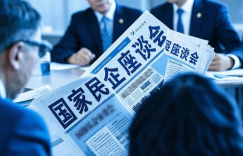
Let’s talk about the “National Unified Market”. This topic has suddenly become popular recently because just 6 days ago on January 7, the National Development and Reform Commission issued a heavyweight document – “Guidelines for the Construction of a National Unified Market (Trial)”, referred to as “Construction Guidelines”. As soon as the document was issued, the reaction was very strong, because this topic is so important, so I will use two lectures to explain it in detail for you – the first lecture will make it clear what this document is for, and the second lecture will make it clear what impact and suggestions it has on you. And by disassembling such a heavyweight document, I will also show you how to read policy documents and take you to practice once.
Before officially starting, I will give you some background information to help you quickly catch up. Let’s first clarify three key points:
First, why is this document called “Construction Guidelines”? Because in 2022, the Central Committee of the Communist Party of China and the State Council jointly issued the “Opinions on Accelerating the Construction of a National Unified Market”. Please note that this is a top-level design document jointly issued by the Central Committee of the Communist Party of China and the State Council, which is the highest level of Chinese document release; and this time the “Construction Guidelines” of the National Development and Reform Commission belong to the “Operation Guide” of the previous document. Understanding this can help you clearly define the positioning of the two documents.
Second, there are very few national documents called “Construction Guidelines”. Only three have been issued in the past ten years, all of which are very important policy documents, so this document deserves your special attention.
Third, the National Development and Reform Commission issued the document this time. This agency has a unique status. It can be said to be the largest ministry of the State Council. People like to call it the “small State Council” privately, and it plays the role of the policy implementation and coordination center. Its issuance means that the policy has reached the stage of accelerated implementation, which is an important signal for enterprises.
Why should we build a national unified market?
Okay, let’s get started.
Students who first heard the “national unified market” may have questions. Aren’t we originally a “national market” as a whole? What else is there to build? Here I will teach you a key skill in policy analysis – that is, look at what new words are added to the name of the new policy compared to the previous one, and then split it apart. This time, the three words “unified and large” were added, and these three words can be split into two keywords: “unified” and “large”.
Why do we mention “unified”? When looking at policies, you need to look at the opposite side of what is not mentioned. This shows that there is a phenomenon of inconsistency in some areas and links, which has hindered the operation of the market. We have mentioned before that we should look at the government with corporate logic. The head office of the group and its subsidiaries, especially the subsidiaries, are not always on the same side. Why do we need to mention “big”? My opinion is that the country now thinks the market is “small”. Why is it small? Because compared with the country’s expectations and the large world market abroad, our current market is small.
And further deduction can be concisely summarized into four sentences – breaking local protection, unifying all rules, expanding the market scale, and preventing external changes.
Let’s explain one sentence at a time.
First, let’s look at the first sentence. What is local protection? For example, in a provincial capital in the central region, a listed bus company was a local star company, so the local government once required that all buses and buses in the jurisdiction must be purchased from it, and foreign companies could not be selected, which formed unfair competition. The above approach is direct and implicit. For example, when the government bids, some places will deliberately raise the entry threshold and restrict the entry of foreign companies, because only by allowing local companies to win the bid can employment, tax revenue, and GDP be retained in the local area.
Secondly, let’s look at the second sentence, unify all rules. What does it mean? Let me continue to give examples. Previously, the State Council had a policy that vegetable agricultural products do not need to pay tolls when going up and down the highway. However, last year, a truck loaded with lettuce in Shandong got off the highway in Nanjing. Because “lettuce has no leaves”, the local government did not recognize it as a vegetable agricultural product. The truck was subsequently required to pay a highway toll, while Yancheng, Xuzhou, Huai’an and other places along the way all recognized it. Another example is the inconsistency of rules caused by different hardware and software facilities. The government systems in various places, including the medical system you are familiar with, are different. Enterprises and ordinary people need to handle cross-regional matters. The country wants to coordinate and even supervise across regions. Sorry, the teeth don’t match. These inconsistencies are common in taxation, finance, supervision, environmental protection, medical and other fields in various places.
Based on the first two sentences, the third sentence to expand the market scale is easy to understand. Because of the two major problems of local protectionism and inconsistent rules, although we had a national market before, it was not a unified large market, but a series of small markets with “regional divisions” and too many “mountains”. Therefore, we must break localism, unify all rules, and expand the market scale, which is the “national unified large market”.
The fourth sentence, preventing external changes, means that another key to accelerating the construction of a unified large market is the external world market, because tariff wars, trade wars, technological blockades, industrial decoupling, etc. have become increasingly uncontrollable. To prevent rapid and extreme changes in the outside world, we must quickly accelerate the internal circulation. Those who understand will understand.
Overall Action Outline
Next, where will the country start to promote a unified national market? According to my analysis, it will start from four aspects: system, facilities, resources, and supervision.
First, in terms of system: build a unified national market for property rights, access, competition, and credit. This is the foundation of the building, and all are basic rules.
Second, in terms of facilities: build a unified national market for logistics, information, and public transactions. This is the steel and cement of the building, the core skeleton.
Third, in terms of resources: building a unified national market for land, labor, capital, technology, data, and energy. These are all production factors, which are the bricks of the building.
Fourth, in terms of supervision: building a unified national market for supervision and law enforcement. This is the protective net and safety officer of the building.
Among these articles, the most core one is the third one, which is about the construction of a unified national market for land, labor, capital, technology, data, and energy in terms of resources. The other three are supporting measures introduced to ensure this one.
Subdivided practices
Okay, after summarizing the outline of the country’s action direction, let’s look at the subdivided practices. Because there are too many, I will focus on the three major events. Due to space limitations, I will not read the corresponding complete clauses, but only the key words and phrases. I have put the original text of the document in the manuscript, and you can compare them.
The first major event is to tear down the walls and allow enterprises, goods and people to flow freely without obstacles.
First of all, we must break down government barriers. The key point behind this is to strictly constrain local governments and prevent them from artificially building high walls.
For example, the document points out that local governments should not strengthen the protection of local products in the form of targeted subsidies, which means that they should not favor local enterprises.
Original text of the document: “Regions should not restrict the free flow of goods and factors across regions… They should not strengthen the protection of local products or specific products in the form of targeted subsidies, local recommended catalogs, etc., and restrict the entry of foreign products into the local market in disguised form.” (Here is the original policy text, the audio is not read, and it is only presented in the manuscript.)
For example, local governments should not illegally limit the location of bidders in bidding and government procurement, which cannot restrict foreign enterprises.
Original text of the document: “Regions and departments should not illegally limit or specify specific patents, trademarks, brands, parts, places of origin, suppliers in bidding and government procurement… Illegal limit the location, organizational form, and ownership form of bidders.” (Here is the original policy text, the audio is not read, and it is only presented in the manuscript.)
For example, market access standards should not be drafted without fair competition review, etc.
The original document reads: “Regions and departments shall not draft laws, administrative regulations, local regulations, rules, normative documents and specific policy measures on market access and exit, industrial development, and qualification standards involving economic activities of business entities without fair competition review or in violation of review standards.” (The original policy text is here, the audio is not read, and it is only presented in the manuscript.)
In short, the above, in simple terms, does not allow “exclusion”.
Secondly, important commodities should be easier to flow. For example, building a backbone circulation corridor for important commodities can be understood as a “highway” dedicated to bulk commodities, such as the backbone circulation corridor for bulk commodities in Jinlu, which is specially used to transport coal and iron ore.
The original document reads: “Support relevant cities to jointly build a backbone circulation corridor for important commodities.” (The original policy text is here, the audio is not read, and it is only presented in the manuscript.)
In addition to important commodities, the circulation of ordinary commodities must also be unobstructed. For example, the document says that overloading and overlimit cannot be arbitrarily limited. To put it bluntly, local governments cannot deliberately block vehicles, let alone stop them and collect money.
Original document: “All regions should focus on opening up dead-end roads, basically eliminating inter-provincial bottleneck sections of the national highway network, and basically opening up major bottlenecks and obstruction nodes of inter-provincial waterways, increase coordination efforts, and break the bottleneck constraints of regional transportation infrastructure.” (Here is the original policy text, the audio is not read, only presented in the manuscript.)
Original document: “All regions shall not formulate and implement local standards that are inconsistent with the national unified truck overload identification standards; they shall not illegally set up road height and width restrictions, inspection checkpoints, or block road routes without reason in the name of traffic control, pollution prevention, etc., to block the connection of regional transportation infrastructure.” (Here is the original policy text, the audio is not read, only presented in the manuscript.)
Finally, in addition to goods, the circulation of people must also be guaranteed, so the document stipulates that “all regions shall not set policy barriers that affect the flow of talents in terms of household registration, region, identity, archives, personnel relations, etc.” As we all know, some cities and some things cannot be done without local household registration, and many units, especially some good units, also restrict household registration, identity, and require archives when recruiting people. I think that in the future, all of these need to be standardized and cleaned up as little as possible.
The second major thing is to make the rules and information of various transactions clear and explicit.
On the one hand, various national service trading platforms should be built. The document clearly mentions the “National Public Resources Trading Platform”, “National Land Secondary Market Trading Service Platform”, “National Unified Electricity Market System”, “National Employment Public Service Platform”, “National Unified Social Security Public Service Platform”, etc. Please note that the latter two platforms, namely the “National Employment Public Service Platform” and the “National Unified Social Security Public Service Platform”, are particularly closely related to us personally. I will analyze them in detail in the next lecture.
These national platforms are equivalent to putting all goods in a large supermarket according to one rule, and all transactions must be put on the national table. Not only should the supply of goods be enriched, but also the “hidden rules” and local barriers of resource transactions should be broken.
On the other hand, it is necessary to achieve transparency of information and access. For example, the document requires that all market access management measures should be included in the negative list. In my opinion, the so-called “inclusion in the negative list” means to clearly state what enterprises cannot do. What is not written is allowed, similar to “what is not prohibited by law is allowed”, so that local governments cannot set up obstacles at will.
Original document: “All regions and departments must strictly implement the ‘one list for the whole country’ management model. All market access management measures set by local governments in accordance with the law must be included in the unified national market access negative list management.” (Here is the original policy text, the audio is not read, only presented in the manuscript.)
The third major thing is to prohibit those who do not implement the rules, implement them arbitrarily, or even implement them illegally, and at the same time try to reduce the vague space.
There is a lot of content in this part, let’s talk about two categories of red lines first:
The first category is to prohibit infringement of the rights and interests of the subject. For example, it is not allowed to freeze the property of the operating entity beyond the authority, and it is not allowed to carry out profit-seeking law enforcement illegally. This is very important, especially for private enterprises. Recently, the central government has been cracking down on various “distant-sea fishing”, that is, cross-regional, to find companies in developed areas to make money to increase revenue. This policy is to build a basic sense of security for enterprises.
The original document reads: “All regions shall not illegally intervene in economic disputes by administrative or criminal means, infringe upon the rights and interests of business entities, and shall not seal, seize, or freeze the property of business entities beyond their authority, scope, amount, or time limit, and shall not illegally carry out law enforcement or implement jurisdiction in other places, and shall prevent and correct profit-seeking law enforcement and judicial activities in accordance with the law.” (Here is the original policy text, the audio is not read, and it is only presented in the manuscript.)
The second category is to prohibit those that undermine fair competition. For example, it is not allowed to implement preferential policies for attracting investment in violation of the red line bottom line. This is to prohibit the vicious competition between various regions, which leads to waste of resources, overall damage, and ultimately a mess. In fact, many industrial parks in many places are now facing the challenge of development that is not as expected, which needs to be taken seriously.
The original document reads: “All regions shall not violate the red line bottom line stipulated by the state and implement preferential policies for attracting investment in finance, taxes, prices, land, resources, and the environment in violation of the regulations.” (Here is the original policy text, the audio is not read, and it is only presented in the manuscript.)
The above is the red line, and the next step is to clean up the gray area and standardize the scale of law enforcement.
For example, the document mentioned that it is necessary to formulate approval standards and compile standardized service guidelines. That is, how to do things, each region should give a list and update it in time, especially for those involving approval, and cannot “control it through the internal window” every day, leaving everyone guessing. You know, one more layer of transparency means one less layer of corruption.
Original text of the document: “Each region should formulate and dynamically update a standardized list of government service items at this level, unify the names, application materials, acceptance conditions and other contents of government service items, and formulate approval standards and compile standardized service guidelines based on the contents of the list.” (Here is the original policy text, the audio is not read, and it is only presented in the manuscript.)
The document also mentioned that it is necessary to clearly define the general terms in normative documents. This sentence has the same logic as the above sentence. How to punish should be clearly stated, and don’t summarize it with a few big words, and then the departments will interpret it at will. In short, the central government should try to reduce the arbitrariness and gray space of local law enforcement.
The original document reads: “Relevant departments and regions should formulate administrative penalty discretion benchmarks based on actual conditions and formulate regulatory rules to regulate the exercise of administrative discretion, refine and quantify specific operational regulations, clearly define the specific circumstances of general terms in normative documents, and establish specific quantitative standards by category to regulate law enforcement standards.” (This is the original policy text, the audio is not read, and it is only presented in the manuscript.)
Okay, now you should have a general understanding of the “Construction Guidelines”. I have also attached a link to the original text at the end of the manuscript. You can combine the original text and compare it with the interpretation of the manuscript to study and review it in detail. As for the impact of the national unified market on us and how we can maximize the policy dividends, I will continue to talk about it in the next lecture. So you must remember to listen to the next lecture.



